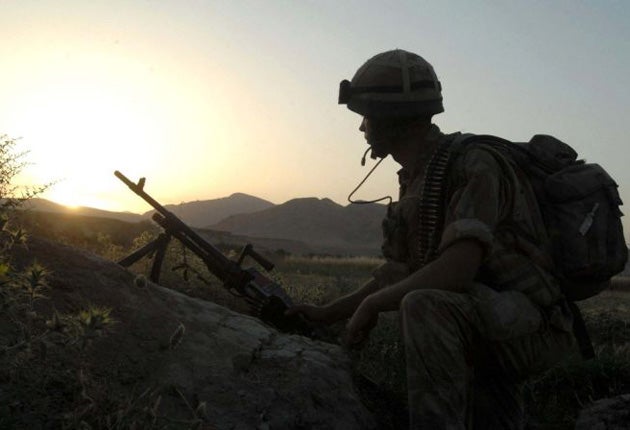Sangin: A quiet end to a mission of unimaginable violence
After four years and 105 deaths, UK forces have left Sangin, writes Kim Sengupta

The handover of Sangin yesterday was an occasion of symbolism and resonance for the British mission in Afghanistan. The ceremony, in a morning of dusty Helmand sunshine, brought to a close a four-year operation in an area where UK forces have been involved in ferocious fighting – this tiny stretch of land claiming almost a third of the 337 British lives lost so far in this war.
The US Marine Corps, whose total strength in Helmand is already double that of the UK force, took over yesterday from 40 Commando Royal Marines, who will redeploy to central Helmand – four years after the 3rd Battalion, the Parachute Regiment were the first British troops to move into Sangin.
The British exit from Sangin has led to criticism from some quarters and analogies being drawn with Basra, from where British troops pulled out, forcing the US Marines to take over. There are also likely be complaints that "blood and treasure" (lives and financial investment) expended by the British forces have been wasted.
Sangin is the last of the formerly British-controlled towns like Musa Qala, Kajaki and Garmsir to have passed into the American sphere of operations. These places, too, had provided some of the most significant chapters for the British deployment. Musa Qala was taken over by the Taliban after a controversial deal with local elders. Garmsir had changed hands repeatedly in bloody fighting and a massive operation was mounted to move a turbine for an electricity generating plant in Kajaki two years ago. The plant, however, is still not fully operational.
But Sangin had totemic resonance because of the sheer scale of the violence. The town and its hinterland is part of a feeder route into the Helmand river valley and Lashkar Gar, where young jihadists cut their teeth. At the same time, some of the Taliban's most proficient bombmakers are based there and the surrounding area contains rich opium fields providing revenue which feeds the insurgency.
The British could, theoretically, have divested themselves of Sangin, and the losses which came with it, earlier. But here a sensitive chapter in Anglo-American relations came into play. There is little doubt that senior officers in the US military were critical of the way UK forces conducted themselves towards the end of their deployment in Iraq – letting militias impose a brutal regime in Basra and then withdrawing altogether when Washington was requesting that they stay on.
So holding Sangin, one of the most dangerous places in Afghanistan, was, some in the UK military hierarchy felt, recompense for what happened in Basra. As one senior officer said: "When you are in alliance you have got to take the tough with the less tough. You cannot expect your ally to deal with all the tough situations." The US commander in Helmand, Major-General Richard Mills, said that the UK forces' performance in Sangin had been "simply nothing short of magnificent".
The move from the area reflects the reality on the ground in Helmand where the US provides the overwhelming majority of forces and the British contingent is under American command.
The Americans have the numbers that the UK did not have to keep boots on the ground in areas taken from the Taliban – although, as the continuing insurgent attacks around Marjah show, even with large numbers it is difficult to hold areas against an insurgency which is being reinforced and armed from across the border in Pakistan.
Lt-General Nick Parker, deputy commander of Nato forces in Afghanistan, insisted that the handover of Sangin did not mean British control of the area had failed. "Everywhere in Afghanistan there are coalition troops who are handing over. In our case we do it once every six months, the Americans do it once a year, and we have a normal process of what we call relief in place," he said. "We have taken the opportunity to use the 40 Commando relief in place to put US troops into the north of Helmand, which is where they can have best effect, and when we bring the next battle group in from the British forces they are going to go into central Helmand."
The people of Sangin send mixed messages. Nasser Muhammed, who moved with his family to Lashkar Gar, complained that districts previously under Afghan government control had fallen to the insurgents despite four years of British presence. But Selim Jalauddin, a shopkeeper who stayed, said: "If it had not been for the British we would all be under the Taliban now – there would be no schools or businesses."
Join our commenting forum
Join thought-provoking conversations, follow other Independent readers and see their replies
Comments
Bookmark popover
Removed from bookmarks